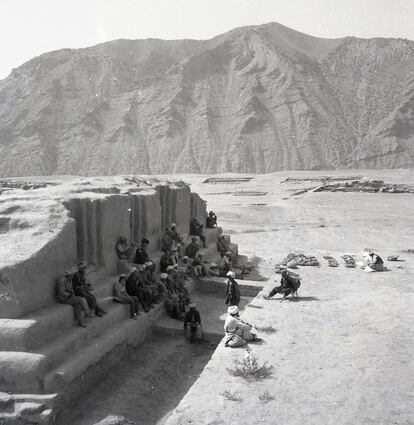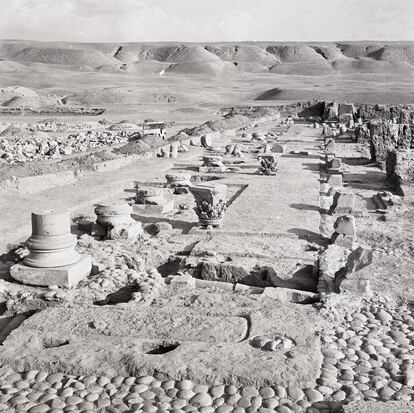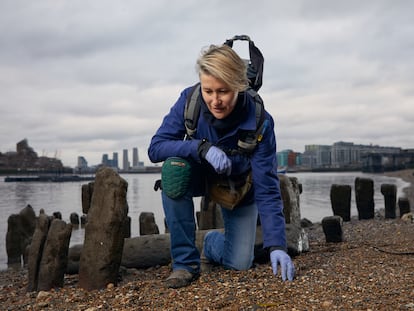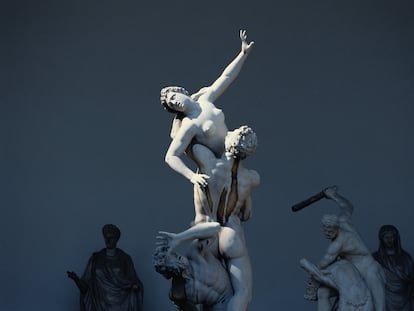A race against destruction: In search of Afghanistan’s lost civilizations
An exhibition in Paris tells the story of a French archaeological mission in Central Asia, which located the easternmost Hellenic city, founded by Alexander the Great in the 4th century BC


Afghanistan is a land where cultures and civilizations have always intersected. For centuries, the territory has been disputed by different empires and torn apart through endless wars.
In the 4th century BC, Alexander the Great founded the mythical city of Ai-Khanoum – the easternmost of the Hellenic cities. There, the Greco-Bactrian Kingdom flourished for nearly 150 years, mixing Hellenic and Buddhist traditions. Majestic giant Buddhas were carved into the mountains of the Bamiyan valley, in the contemporary region of central Afghanistan. Despite an international outcry, they were dynamited by the Taliban regime in 2001, shortly before the coalition invasion of the country.
The ancient remains of Afghanistan were entombed by centuries of oblivion, or plundered by the many empires that passed through the territory. But after World War I, the newly-created independent state of Afghanistan – long fought over by the Russians and the British – decided to entrust France with the creation of an archaeological mission aimed at unearthing all those lost vestiges.
DAFA – the French Archaeological Delegation in Afghanistan – had a cultural mission. But King Amanullah Khan, presiding over a new country, also had a political motivation: he needed to formalize a past that could support the national aspirations of his government.
This scientific adventure was interrupted by the Soviet invasion of 1979. The arrival of Moscow’s troops plunged the country into a series of civil wars that has not yet ended, ruining most of the heritage unearthed during those decades of excavation.
One loss is particularly symbolic: the destruction of the remains of Ai-Khanoum – Uzbek for “lady of the moon” – discovered by a French archaeologist in 1926, although excavation did not begin until the 1960s.
This is how Oxford classicist Robin Lane Fox describes the city in his biography of Alexander the Great: “In Afghanistan – where the Kokcha River flows from the mountains and blue mines of Badakhshan, overlooking the corridor through the Pamirs towards China – the huge Greek city of Ai-Khanoum came to light in the 1960s. Some 3,000 miles away from the Aegean Sea, there were Greek, Macedonian and Thracian citizens, who enjoyed the temples, the gymnasiums and the arenas exactly as if they were in a city on the Greek mainland.”
“Many sites have since been destroyed. Ai-Khanoum was totally looted in the 1980s and 1990s,” Nicolas Engel tells EL PAÍS via telephone from Paris. As the head of Afghan antiquities at the Guimet Museum in Paris, he is currently curating an exhibition on the city.
The agreement between Afghanistan and France established an equitable distribution of what was found. With the return of the Taliban to power in 2021, the question now is how to preserve the pieces of architectural heritage that have survived, such as the Hindu Kush fortresses.

Following the destruction and atrocities that the Soviets inflicted on Afghanistan throughout the 1980s, the civil wars of the 1990s pitted different warlords against each other. The country plunged into anarchy, which gave the Taliban – the “students” – the opportunity to take control of most of the country in 1996. The Islamist militia imposed the harshest form of Sharia law in Afghanistan, erasing women from public life. They also sought to eradicate any traces of the country’s non-Islamic past.
The destruction of the Buddhas of Afghanistan in 2001 was not unrelated to the fact that the statues – which were built in the 5th or 6th century – were located in the middle of Hazara territory. The Hazaras are an Afghan ethnic group of the Shiite sect of Islam. They have long been persecuted by the Taliban, who wish to ethnically cleanse them from the land.
With the return of the Taliban regime to power – following the chaotic American withdrawal in the summer of 2021 – many archaeologists fear a return to the days of the Taliban’s iconoclastic fury. The Taliban are also known to use the lucrative antiquities trade to finance their crimes.
A cultural crossing
Ai-Khanoum is not only a Hellenic city. As occurs in a region where many cultures meet, it is an ancient city mixed with the traditions of Central Asia.
“It has a hybrid architecture, with strong oriental influences,” says Engel. The city was preserved intact – it was abandoned in the 2nd century BC. Greek columns stand alongside bricks from the area.
“What is certain is that, two centuries after Alexander the Great, Greek was still spoken, although the people had local names,” continues Engel, referencing several manuscripts that were found during the excavations.
“The Greek gods were worshipped by the new settlers,” writes Lane Fox. Ai-Khanoum was an example of the power of culture, with armies transporting it from the shores of the Mediterranean to the other side of the world.
Several of the city’s objects were taken to France, while others remained in the Kabul Museum. Many were stolen from the capital, although some of the most important treasures were hidden in the Central Bank, awaiting better times. However, when the French archaeologists were forced out by the Soviets, the ruins were totally looted.
When the US-backed Northern Alliance forces fought the Taliban in 2001 to push them out of power, Ai-Khanoum was caught on the frontlines. In the rush to defeat the brutal regime that was harboring Al Qaeda following the 9/11 attacks, whatever little was left of the ruins could not be saved.
The rediscovery of Ai-Khanoum reflects the enormous difficulties involved in the process of excavating in Afghanistan. After King Zahir Shah took a renewed interest in the site in 1961 (after the initial French discovery in 1926), 16 research campaigns began, which lasted a total of 13 years. Led by French archaeologist Paul Bernard, the team discovered numerous documents and inscriptions, providing a glimpse into the lives of the Macedonian settlers in Central Asia.
All this work made it possible to solve a few riddles… but there wasn’t enough time to uncover all the mysteries of the civilization nestled in central Afghanistan. “An unattainable country, Afghanistan constitutes a dreamed literary and historical horizon,” writes Sophie Makariou, another curator of the exhibit in Paris. “France has not given up believing that things can continue to be done in Afghanistan, to think that it is possible to protect and transmit this history. A new chapter will someday be written.”
Meanwhile, with the Afghan people submitted to a new reign of terror, the silence of a lost world has returned.
Sign up for our weekly newsletter to get more English-language news coverage from EL PAÍS USA Edition
Tu suscripción se está usando en otro dispositivo
¿Quieres añadir otro usuario a tu suscripción?
Si continúas leyendo en este dispositivo, no se podrá leer en el otro.
FlechaTu suscripción se está usando en otro dispositivo y solo puedes acceder a EL PAÍS desde un dispositivo a la vez.
Si quieres compartir tu cuenta, cambia tu suscripción a la modalidad Premium, así podrás añadir otro usuario. Cada uno accederá con su propia cuenta de email, lo que os permitirá personalizar vuestra experiencia en EL PAÍS.
¿Tienes una suscripción de empresa? Accede aquí para contratar más cuentas.
En el caso de no saber quién está usando tu cuenta, te recomendamos cambiar tu contraseña aquí.
Si decides continuar compartiendo tu cuenta, este mensaje se mostrará en tu dispositivo y en el de la otra persona que está usando tu cuenta de forma indefinida, afectando a tu experiencia de lectura. Puedes consultar aquí los términos y condiciones de la suscripción digital.
More information
Archived In
Últimas noticias
Most viewed
- Oona Chaplin: ‘I told James Cameron that I was living in a treehouse and starting a permaculture project with a friend’
- Reinhard Genzel, Nobel laureate in physics: ‘One-minute videos will never give you the truth’
- Sinaloa Cartel war is taking its toll on Los Chapitos
- Why the price of coffee has skyrocketed: from Brazilian plantations to specialty coffee houses
- Chevy Chase, the beloved comedian who was a monster off camera: ‘Not everyone hated him, just the people who’ve worked with him’










































